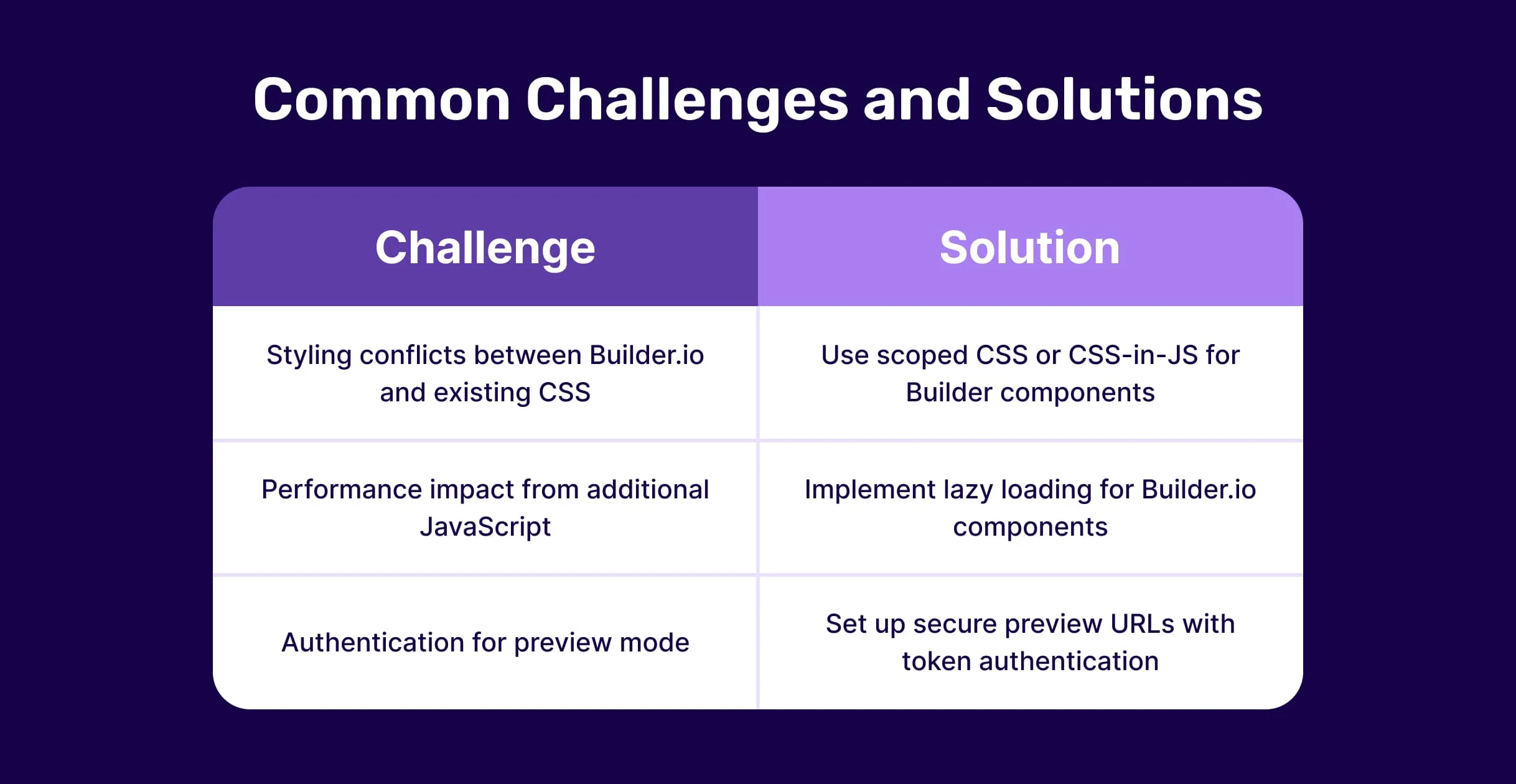Select Your Region
Region-Based Optimized Content
How to Integrate Builder.io With Your Existing Website or App
Learn how to integrate Builder.io into your existing website or app using SDK, API, or iframe. Enable visual editing without a full rebuild or complex migrations.
Modern businesses need flexibility in how they manage and update their digital experiences. Builder.io offers a powerful visual content management system (CMS) that integrates seamlessly with existing websites and applications no full rebuild required. Whether you’re running a legacy platform, a headless setup, or a hybrid architecture, integrating Builder.io enables marketers and developers to collaborate efficiently while maintaining control over the tech stack.
Why Integrate Builder.io With an Existing Platform?
Builder.io bridges the gap between development and content teams by providing a no-code visual editor that plugs into your live environment. Here’s why it’s a strategic choice:
No Replatforming Needed: Avoid costly and time-consuming migrations by adding Builder.io as a layer on top of your current setup.
Visual Editing for Non-Technical Teams: Marketers can update content, A/B test layouts, and publish changes without developer intervention.
Headless Flexibility: Works with any frontend framework (React, Vue, Angular, etc.) or traditional CMS.
API-First Approach: Content is delivered via APIs, making it easy to reuse across multiple channels.
Key Integration Methods
Depending on your tech stack and use case, Builder.io offers multiple integration approaches.
1. Using the Builder.io SDK
The Builder.io JavaScript SDK is the most common way to embed the platform into an existing application. Here’s a basic example for a React app:
import { builder, BuilderComponent } from '@builder.io/react';
// Initialize Builder.io with your API key
builder.init('YOUR_API_KEY');
function Page() {
return <BuilderComponent model="page" />;
}This renders a page from Builder.io within your React component. The SDK automatically fetches and hydrates content, making it fully interactive.
2. iframe Embed for Legacy Systems
For older systems where JavaScript integration isn’t feasible, Builder.io provides an iframe-based embed option:
<iframe
src="https://builder.io/content/YOUR_PAGE_ID"
width="100%"
height="100%">
</iframe>While less flexible than the SDK, this method works with virtually any platform, including WordPress, Shopify, or custom PHP applications.
3. API-Driven Content Fetching
For full control, you can fetch Builder.io content via its REST or GraphQL API and render it manually:
fetch('https://cdn.builder.io/api/v1/content/page?apiKey=YOUR_API_KEY&url=/current-path')
.then(res => res.json())
.then(data => {
// Render content using your own logic
});Step-by-Step Integration Guide
1. Set Up Your Builder.io Account
Sign up for a Builder.io account and create a new organization.
Navigate to the API Keys section and copy your public API key.
2. Install the SDK
Add the appropriate Builder.io SDK to your project:
For npm/yarn:
npm install @builder.io/reactFor CDN:
<script src="https://cdn.builder.io/js/webcomponents"></script>
3. Configure Content Models
In Builder.io, define content models that match your existing page structures. For example:
Create a "page" model for full-page layouts
Add "banner" or "promo" components for partial updates
4. Implement Preview Mode
Enable in-context editing by setting up preview URLs in Builder.io that match your development and production environments.
5. Deploy and Test
Gradually roll out Builder.io sections while monitoring performance and functionality.
Hi, my name is Jaswinder, let's talk about your business needs.
I will do my best to find a reliable solution for you!
Advanced Integration Strategies
1. Personalization and A/B Testing
Builder.io built-in targeting rules allow you to:
Show different content based on user segments
Run visual A/B tests without code changes
Schedule content changes in advance
2. Hybrid Content Approach
Combine static and dynamic content by using Builder.io for specific sections while keeping other parts of your site in your existing CMS. For example:
Static product pages in Shopify + dynamic marketing banners from Builder.io
Core navigation in WordPress + promotional content in Builder.io
Common Challenges and Solutions
 Challenge: Styling conflicts between Builder.io and existing CSS
Challenge: Styling conflicts between Builder.io and existing CSS
Solution: Use scoped CSS or CSS-in-JS for Builder components
Challenge: Performance impact from additional JavaScript
Solution: Implement lazy loading for Builder.io components
Challenge: Authentication for preview mode
Solution: Set up secure preview URLs with token authentication
Frequently Asked Questions
Find answers to the most common questions about Integrate Builder.io With Your Existing Website or App
Builder.io outputs clean, semantic HTML and supports server-side rendering. For optimal SEO, ensure your implementation follows best practices for metadata and structured data.
The impact is minimal when properly implemented. The SDK is optimized for performance, and you can control loading behavior to prioritize critical content.
Yes, Builder.io supports role-based access control, allowing marketing, design, and development teams to work simultaneously with appropriate permissions.
Builder.io includes built-in version history and draft/publish workflows, making it easy to roll back changes or schedule updates.
News & Insights
We like to share our thoughts on topics we find inspiring. Explore our news and insights.
Why Sanity Is a Leading Headless Commerce Platform in 2026
Sanity is redefining headless commerce with real-time content, API-first architecture, and AI-ready personalization. Explore its benefits, practical applications, and how RW Infotech enables businesses to maximize results using Sanity.
How to Enhance the Buying Experience for Custom Promo Products
Discover simple and effective ways to enhance the buying experience for custom promo products through personalization, smooth ordering, and customer-focused improvements.